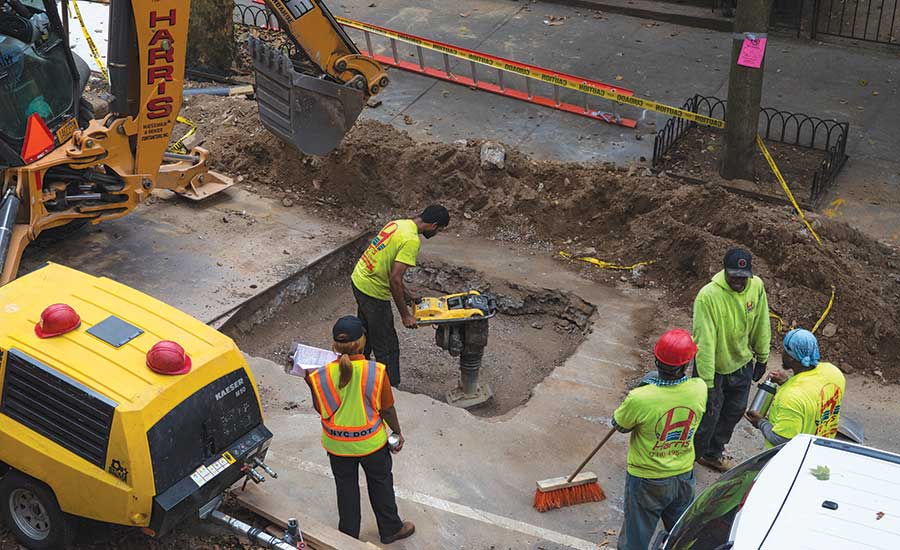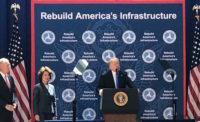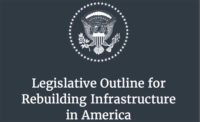Months of waiting are over as President Trump has finally laid on the table a detailed outline of his long-promised infrastructure investment plan, which the administration says will produce at least $1.5 trillion for transportation, water and other projects over 10 years and trim federal project permitting time to no more than two years. The release of the 55-page framework marks the start of a new stage for the proposal as lawmakers on Capitol Hill begin to put their stamp on it.
“The ball is in Congress’ court,” says Steve Hall, American Council of Engineering Companies’ vice president for government affairs. “Really, in a serious way, now it will be the beginning of the process.”
The plan, released on Feb. 12, seeks congressional approval for $200 billion in direct federal funding. The fiscal 2019 installment would be $45 billion, according to Trump’s 2019 budget request. When combined with what the White House expects will be matching funds from state and local governments, plus the private sector, the grand total will be $1.5 trillion or more in total investment, the administration says. Critics say that figure won’t be reached.
In a Feb. 10 briefing for reporters, a senior White House official acknowledged that the plan is far from the last word. “This is the start of a negotiation,” the official said, “a bicameral, bipartisan negotiation on how to find the best solutions for infrastructure in the U.S.”
He also said, “We envision this will be a bipartisan push,” but conceded that there is “disagreement” about the best way to achieve infrastructure investment goals.
Disagreement has already surfaced. Democrats slammed the plan, contending that $200 billion in federal funding is far too little. They also object to Trump’s proposed cuts to other infrastructure programs to help offset the $200 billion. Senate Minority Leader Chuck Schumer (D-N.Y.) said, “The Trump plan has the skin of an infrastructure plan, but it lacks the guts.” He added, “The lack of direct investment would leave out large parts of America, particularly rural America, where local governments don’t have the money or the traffic to attract private-sector investment.”
The House Transportation and Infrastructure Committee’s top Democrat, Peter DeFazio (Ore.), called the proposal “embarrassingly small.” He added, “This is not a real infrastructure plan—it is simply another scam, an attempt to sell our nation’s infrastructure and create windfall profit for Wall Street while rolling back environmental protections.”
House Democrats on Feb. 8 announced their own $1-trillion, 10-year infrastructure proposal, with all of that money to come from federal spending. House and Senate Democrats had rolled out a similar plan in early 2017.
Democrats’ criticism matters because their votes are needed to pass an infrastructure bill. Hall says, “At the end of the day it’s going to have to be bipartisan. Otherwise, a bill doesn’t get out of the Senate, and to do that, you need money.”
The senior official said that the administration will be “quite flexible” in its stance toward ways of achieving its main infrastructure goals.
The proposal aims to assist a range of infrastructure types, such as highways, drinking-water and wastewater-treatment, river locks and dams, ports, energy, and broadband. But it doesn’t specify how much of the federal or non-federal dollars should go to each category. Instead, it would rely largely on states and localities to set priorities.
Kristina Swallow, American Society of Civil Engineers’ president, called the Trump plan “a solid first step in having a real conversation about solutions for the nation’s aging infrastructure and a path to address our infrastructure investment deficit.” But Swallow and other infrastructure advocates also want to see a remedy for the Highway Trust Fund’s revenue shortfall.
The Transportation Construction Coalition, comprising 31 industry and organized-labor groups, praised Trump’s plan for “wisely seeking to change the dialogue” about infrastructure, and providing resources to improve, not just maintain it. But the coalition said, “There is no better way to do just that than by passing a package that includes a permanent, growing, user-based Highway Trust Fund revenue solution.” That’s not in the proposal now.
At least one key Republican, House transportation panel Chairman Bill Shuster (R-Pa.), agrees. He hailed the Trump proposal but indicated a bill must also address the trust fund’s “long-term sustainability.”
In a non-transportation sector, the National Association of Clean Water Agencies was pleased to see water infrastructure included in the proposal, CEO Adam Krantz said. But he’s concerned that the plan “may be overly ambitious” about how much non-federal revenue will be there, especially in the water sector. NACWA is calling for more direct federal funding than the $200 billion.
The administration wants to offset the $200 billion by cutting other accounts, specified in Trump’s 2019 budget request. They include zeroing out the popular Transportation Investment Generating Economic Recovery, or TIGER, grants and slashing transit capital investment grants by 59%, to $1.4 billion. The administration feels those programs haven’t spent money “efficaciously,” the White House official said. Trump proposed identical or similar cuts in his fiscal 2018 budget request last year, and Congress rejected them.
Faster Permitting
The administration also has emphasized the plan’s provisions to expedite permitting. The senior official said that under the plan, federal environmental reviews, up to the signing of a “record of decision,” would take no more than 21 months. Issuing a permit would take a maximum of three months beyond that. The proposal also has educational provisions and other steps to improve the workforce.
The framework also would designate one agency to lead federal reviews for each project, with the choice of an agency depending on the type of project. He also said the White House will seek to give more permitting authority to the states.
Of the $200 billion, half would go for an “incentives” program in which non-federal entities would seek federal grants by pledging matching funds. Rural infrastructure block grants would get $50 billion; $20 billion of that would expand existing federal infrastructure loan activity, including the Transportation Infrastructure Finance and Innovation Act program. Another $20 billion would be for “transformative programs,” the White House official said, for a “next-century type of infrastructure.” The other $10 billion would support a new federal revolving fund to purchase real estate.
Related Article: Trump FY19 Budget Mixed for Construction






